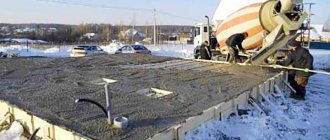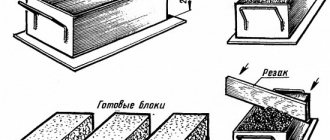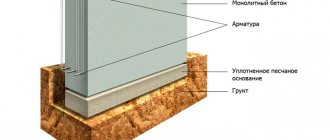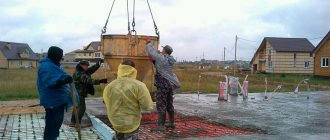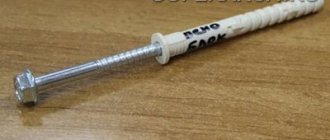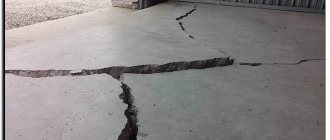Building a house in which a large family will gather to celebrate holidays and joyful events together is the dream of any man. As a rule, every owner who wants to build his own house has many questions that he wants to figure out on his own, without turning to the help of specialists. This will amuse your vanity and save you a lot of money. However, most men are stopped by the same problem - deciding what time of year to build a house. Previously, it was believed that this was only possible in the summer, but scientific progress makes it possible to build housing in the winter. The only caveat is that you should find out in advance at what temperature concrete work can be carried out.
Advantages and disadvantages of winter work
Concreting at subzero temperatures has its advantages and disadvantages, which should not be forgotten.
Concreting at subzero temperatures has its advantages
Advantages:
- Possibility of pouring concrete on loose soil. In the warm season, the soil crumbles, which makes it difficult to properly lay the coating.
- Lower cost of work. The winter period is traditionally considered unsuitable for construction, so many stores offer discounts on materials needed to build a house.
- Expedited provision of services. Unpleasant weather literally forces employees to work faster, which significantly reduces time costs.
Flaws:
- When choosing workers, you should consider craftsmen who are capable of pouring concrete in winter. This is due to the fact that most construction workers only work in the summer.
- There is a high risk that the concrete mixture will freeze, and construction work will have to be suspended until the external temperature reaches positive values.
- In winter, daylight hours are shorter than in summer, so you will need to buy equipment for additional lighting. As a rule, this requires considerable expenditure.
- Pouring a foundation on frozen ground risks subsidence and the appearance of cracks, since the ground sags as it freezes.
Conclusion
The quality of winter concrete produced in violation of technology will be low, and the level of adhesion to metal reinforcement will be insufficient. Buildings and structures constructed using such material are considered fragile and dangerous for use.
The time it takes to deliver concrete to the site should be minimal. Therefore, the best option is to produce concrete in your own mobile plant, such as the TRUMIX winter concrete batching plant.
Our website presents models of all-season concrete plants at competitive prices. Leave a request on the website or call the phone number. Our manager will definitely call you back, answer questions, and help you place an order.
How do negative temperatures affect concrete?
According to clause 5.3.15. SP 70.13330.2012 SNiP 3.03.01-87, laying concrete at subzero temperatures is possible only if special conditions are created that ensure the necessary properties of concrete.
Only under special conditions is it possible to pour concrete at subzero temperatures
Solution quality at different temperatures
Laying concrete at sub-zero temperatures leads to irreparable changes in the structure.
In this regard, you should remember the features of working in winter:
- a solution prepared in the summer heat has a higher durability and hardens faster than a mixture prepared in winter;
- When working in icy cold conditions, the quality of the solution drops sharply. This is evidenced by visible deformation of the product. Therefore, the concrete placement temperature must be above 0°C.
Physico-chemical processes
Maturing of concrete at low temperatures takes more time and risks the appearance of defects in the finished structure. The lowest temperature for the natural course of the process is considered to be +4 °C.
Hydration of concrete at subzero temperatures slows down, chemically unbound water turns into ice, increasing its volume by 9.7%. Because of this, stresses arise in the mixture, which destroy its structure. Frozen concrete gains high strength due to the adhesion of frozen water molecules, but this does not last long.
When the temperature of the outside world increases above 0 degrees, the water will begin to thaw, which will resume hydration. But changing the structure of concrete will not allow it to gain the required design strength. Research shows that the effect of low temperature does not change the physical and chemical characteristics of concrete if the mixture has gained 30-50% of its design strength before freezing.
It takes longer for concrete to mature at low temperatures
Setting and hardening of concrete at low temperatures by day
To find out the most appropriate time to start construction work, you should pay attention to the graph, which shows the hardening of concrete at low temperatures. Each manufacturer of building materials places a table with information about concrete hardening at low temperatures on the packaging. The best time is considered to be the moment when the concrete strength is at least 72%. To better understand how to calculate working time, you should study an example that describes the setting of concrete at low temperatures by day.
Winter concreting methods
If work is carried out at low temperatures, care should be taken in advance to ensure that the solution does not freeze. Experienced builders have chosen several methods that allow concrete work to be carried out at subzero temperatures.
Temperature increase during kneading
Working with mercury levels below 0°C has its own specifics. Before laying the mixture, it must be heated to a certain temperature. The procedure is aimed at increasing the threshold of critical strength of concrete. This is the value that determines the minimum strength that concrete needs to gain before frostbite. Working in cold weather increases the risk that the concrete structure will collapse and its further maturation will be impossible.
Heating and insulating the solution
Scientific advances offer many different techniques to achieve the required temperature.
Scientific achievements offer many different methods
Among the most popular are:
- Internal heating of a building structure. Special wires are laid from inside the ceiling. This creates the necessary conditions for the solution to harden.
- Heating the mixture from the outside. They increase the ambient temperature in a certain area of construction work. For successful concreting, heat guns (construction heaters) and collapsible structures (“heathouses”) are used.
- Permanent thermal insulation formwork. This method is applicable if the temperature of the outside world is at least – 5°C. This system provides conditions for concrete to harden using the required temperature.
Use of antifreeze additives
Experienced craftsmen use antifreeze additives along with heating the solution.
Professionals claim that this is an affordable and simple method of concreting at low temperatures. The compositions are divided into 2 groups:
- Inhibiting the process of water crystallization. The compositions contain components that ensure polymerization of the solution in the cold.
- Accelerating hardening. Using these components, builders reduce the hardening time of concrete.
As a rule, antifreeze components make up 2-10% of the cement base. Their use makes it possible to operate at temperatures of -25 °C.
Antifreeze additives are used for construction work in winter.
Among the most common antifreeze additives:
- potassium carbonate (potash). This component gained its popularity due to the fact that it does not provoke the formation of rust on metal structures. The polymerization process continues even at -25 °C. The use of potash guarantees the absence of salt traces. However, potassium carbonate has its own peculiarity - the mixture sets quickly. So it is recommended to use the solution no later than 50 minutes from the moment of preparation;
- sodium nitrite. This modifier makes it possible to carry out construction work at temperatures down to -19 °C, and also provides anti-corrosion properties. However, the use of this component leads to the appearance of salt traces on the finished product;
- calcium chloride. Promotes hardening of concrete, even if it is -20 °C outside, and also increases the speed of setting of the mixture. Due to its nature, the composition can leave salt stains on hardened concrete.
Preparing the base and laying the concrete mixture
In winter, when laying concrete mixtures, it is necessary to ensure a base temperature of at least 5°C. At air temperatures below minus 10 °C, it is recommended to carry out concreting of structures with pre-heating of reinforcement and embedded parts to a positive temperature. To ensure strong and tight adhesion of the old concrete base to the freshly laid concrete mixture, it is necessary to remove the surface cement film from the entire concreting area, cut off sagging old concrete and areas with a damaged structure, clean the concrete surface from debris and dust, and before starting concreting, blow off the surface of the old concrete with a jet compressed air. All structures and their elements that are covered during subsequent work (prepared structural foundations, reinforcement, embedded products, etc.), as well as the correct installation and fastening of the formwork and its supporting elements must be accepted by the work manufacturer. The position of previously installed reinforcement must be checked before concreting for compliance with the working drawings. In this case, you should pay attention to the outlets of the reinforcement, embedded parts and sealing elements, which must be cleaned of rust and traces of concrete. Laying and compaction of the concrete mixture should be carried out according to the Work Project (WDP) in such a way as to ensure the specified density and homogeneity of concrete that meets the established quality requirements. The order of concreting should be established, providing for the location of concreting seams, taking into account the construction technology of the structure and its design features. In this case, the required contact strength of the concrete surfaces in the concreting seam must be ensured, as well as the strength of the entire structure, taking into account the presence of concreting seams. When concreting massive structures with self-compacting concrete mixtures, it is possible to lay them simultaneously over the entire site of the structure with mutually overlapping zones of spreading of the mixture. The concrete mixture can be laid either in buckets or with concrete pumps. Before compacting each layer to be laid, the concrete mixture should be evenly distributed over the entire area of the structure to be concreted. The height of individual protrusions above the general surface level of the “thick” concrete mixture before compaction should not exceed 10 cm. It is prohibited to use vibrators to redistribute and level the layer of concrete mixture being laid. The concrete mixture in the laid layer should be compacted only after it has been distributed and leveled on the surface to be concreted. Laying the next layer of concrete mixture must be done before the concrete of the previous layer begins to set. The duration of the break between laying adjacent layers of concrete mixture without forming a working joint is established by the construction laboratory. The surface of the working joints made when laying the concrete mixture intermittently must be perpendicular to the axis of the columns and beams being concreted, the surface of the slabs and walls. Concreting may be resumed once the concrete reaches a strength of at least 1.5 MPa. The location of working concreting joints must be agreed upon with the design organization. The top level of the laid concrete mixture should be 5 - 7 centimeters below the top of the formwork. When compacting the concrete mixture, it is not allowed to rest vibrators on reinforcement and embedded parts and formwork fastening elements. The depth of immersion of the deep vibrator into the concrete mixture should ensure its deepening into the previously laid layer by 5 - 10 cm. The step of rearranging the deep vibrators should not exceed one and a half radius of their action. The concrete mixture in each laid layer or at each position of the vibrator tip is compacted until subsidence stops and until cement paste appears on the surface of the concrete mixture and air bubbles stop escaping. Vibrating screeds, vibrating bars or platform vibrators can be used to compact a layer of concrete mixture no more than 25 cm thick.
Features of pouring concrete under different weather conditions
Pouring concrete in hot weather
Pouring concrete in scorching heat will be a real challenge for those who like to procrastinate.
The real test will be pouring concrete in scorching heat.
The floor hardens quickly, so you must adhere to certain rules:
- mandatory use of waterproofing. Even if it is not required due to weather conditions, its presence will not allow moisture to seep into the soil;
- a larger number of employees will increase the speed of work and ensure high-quality surface coverage;
- finishing the slab in two ways - with an aluminum float and a steel object - will provide a high-quality coating;
- to get a little extra time to complete the job, you should use a wetter mixture;
- You should start moistening the slab immediately after the treated surface has hardened.
Work in the cool season
When working in frosty weather, concrete hardens slowly. Once the slab is laid, you need to wait at least an hour before starting to grout by hand.
Due to the fact that performing this stage requires greater speed than the same actions on a hot day, you need to follow some tips:
- Do not moisten the concrete more than necessary;
- if weather conditions do not require the use of polyethylene waterproofing, it is worth allowing moisture to escape into the ground. This will speed up the hardening of the concrete;
- you should fill the area with the mixture as early as possible, this will ensure faster readiness for work, since during the day the air temperature is higher, and accordingly, the mixture hardens faster.
Concrete hardens slowly when working in frosty weather
Pouring concrete in cold weather
Pouring concrete at subzero temperatures requires the creation of special conditions. The solution should not freeze, otherwise the finely sanded surface of the slab will become mushy.
To ensure the best possible coverage when working in cold weather, there are a few things you need to remember:
- You should ask your supplier to mix the solution with warm water on days when the temperature is below freezing. This helps to avoid problems when transporting the mixture;
- the addition of quicklime to the mixture accelerates the initial hardening of concrete and will more firmly resist destructive factors during thawing or freezing. The amount of lime is usually 0.5 - 2% by weight of the mixture;
- It is important to remember that using a large amount of mixture is just as problematic as working in hot weather. The addition of lime makes the composition aggressive towards steel; this component cannot be used when working with concrete reinforced with steel structures;
- you should make sure that the crushed stone cushion is not frozen;
- it is necessary to provide additional heating to the building in which the work is being carried out;
- cover the finished slab with polyethylene and cover it with a layer of hay or straw more than 100 mm thick to provide thermal insulation.
Recommendations for winter concreting
Due to its chemical composition, concrete at sub-zero temperatures is not able to maintain good quality.
If you want to lay the mixture in the cold, you should follow some rules:
- it is necessary to prepare auxiliary structures. It is necessary to clear the formwork from ice and sediment and heat the reinforcement structures and the bottom until the required temperature is reached. This will require heating elements;
- use of slab foundation. This makes it impossible to maintain the required temperature in icy cold weather. Experienced builders fill this type of foundation only when the mercury is above 0°C or slight frost;
- use of strip foundation as a base. Due to the possibility of performing the work in stages, this option is most suitable for the construction of housing in cold weather. It is better to create heating complexes for hardening concrete in certain areas;
- continuity of work. If the foundation must be poured in sections, each subsequent location must be filled before the first one sets;
- combination of methods. Practice shows that the best results can be achieved when using several methods of winter concreting.
Even despite all the accessibility of construction in the frosty season, it is necessary to remember that this entails extra costs of time, money and effort. Therefore, it is better to pour concrete in the warm season.
Requirements for concrete mixtures
When constructing monolithic structures, it is recommended to supply ready-made concrete mixtures. The selection of the composition of the “winter” concrete mixture should be made only according to the “concrete mixtures of a given quality” option. The basis for selecting the composition should be taken as the determining indicator of concrete for a given type of concrete - strength. At the same time, other indicators of concrete quality must be ensured. The composition of a concrete mixture of a given quality is selected in accordance with GOST 27006, taking into account the requirements for the service classes of concrete in accordance with GOST 31384. Concrete mixtures must meet quality indicators for workability, delamination, porosity, temperature, retention of properties over time, volume of entrained air and compaction coefficient. Transportation of “winter” concrete mixture should be carried out by concrete mixer trucks. Restoring the mobility of the concrete mixture at the place of placement is allowed only with the help of plasticizer additives under the control of a construction laboratory. It is recommended to supply concrete mixtures into the formwork using concrete pumps.
